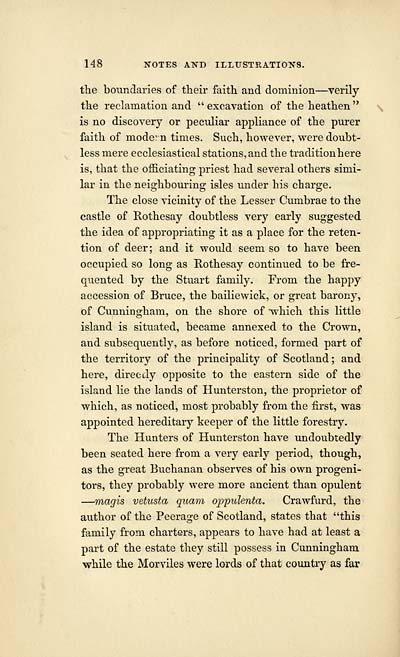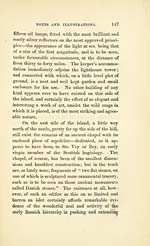Historical memoir of the family of Eglinton and Winton
(172) Page 150
Download files
Complete book:
Individual page:
Thumbnail gallery: Grid view | List view

148 NOTES AND ILLUSTRATIONS.
the boundaries of their faith and dominion — verily
the reclamation and " excavation of the heathen "
is no discovery or peculiar appliance of the purer
faith of mode: n times. Such, however, were doubt-
less mere ecclesiastical stations, and the tradition here
is, that the officiating priest had several others simi-
lar in the neighbouring isles under his charge.
The close vicinity of the Lesser Cumbrae to the
castle of Rothesay doubtless very early suggested
the idea of appropriating it as a place for the reten-
tion of deer; and it would seem so to have been
occupied so long as Rothesay continued to be fre-
quented by the Stuart family. From the happy
accession of Bruce, the bailiewick, or great barony,
of Cunningham, on the shore of which this little
island is situated, became annexed to the Crown,
and subsequently, as before noticed, formed part of
the territory of the principality of Scotland; and
here, directly opposite to the eastern side of the
island lie the lands of Hunterston, the proprietor of
which, as noticed, most probably from the first, was
appointed hereditary keeper of the little forestry.
The Hunters of Hunterston have undoubtedly
been seated here from a very early period, though,
as the great Buchanan observes of his own progeni-
tors, they probably were more ancient than opulent
— magis vetusta quam oppulenta. Crawfurd, the
author of the Peerage of Scotland, states that "this
family from charters, appears to have had at least a
part of the estate they still possess in Cunningham
while the Morviles were lords of that country as far
the boundaries of their faith and dominion — verily
the reclamation and " excavation of the heathen "
is no discovery or peculiar appliance of the purer
faith of mode: n times. Such, however, were doubt-
less mere ecclesiastical stations, and the tradition here
is, that the officiating priest had several others simi-
lar in the neighbouring isles under his charge.
The close vicinity of the Lesser Cumbrae to the
castle of Rothesay doubtless very early suggested
the idea of appropriating it as a place for the reten-
tion of deer; and it would seem so to have been
occupied so long as Rothesay continued to be fre-
quented by the Stuart family. From the happy
accession of Bruce, the bailiewick, or great barony,
of Cunningham, on the shore of which this little
island is situated, became annexed to the Crown,
and subsequently, as before noticed, formed part of
the territory of the principality of Scotland; and
here, directly opposite to the eastern side of the
island lie the lands of Hunterston, the proprietor of
which, as noticed, most probably from the first, was
appointed hereditary keeper of the little forestry.
The Hunters of Hunterston have undoubtedly
been seated here from a very early period, though,
as the great Buchanan observes of his own progeni-
tors, they probably were more ancient than opulent
— magis vetusta quam oppulenta. Crawfurd, the
author of the Peerage of Scotland, states that "this
family from charters, appears to have had at least a
part of the estate they still possess in Cunningham
while the Morviles were lords of that country as far
Set display mode to:
![]() Universal Viewer |
Universal Viewer | ![]() Mirador |
Large image | Transcription
Mirador |
Large image | Transcription
Images and transcriptions on this page, including medium image downloads, may be used under the Creative Commons Attribution 4.0 International Licence unless otherwise stated. ![]()
| Histories of Scottish families > Historical memoir of the family of Eglinton and Winton > (172) Page 150 |
|---|
| Permanent URL | https://digital.nls.uk/94849318 |
|---|
| Description | A selection of almost 400 printed items relating to the history of Scottish families, mostly dating from the 19th and early 20th centuries. Includes memoirs, genealogies and clan histories, with a few produced by emigrant families. The earliest family history goes back to AD 916. |
|---|

